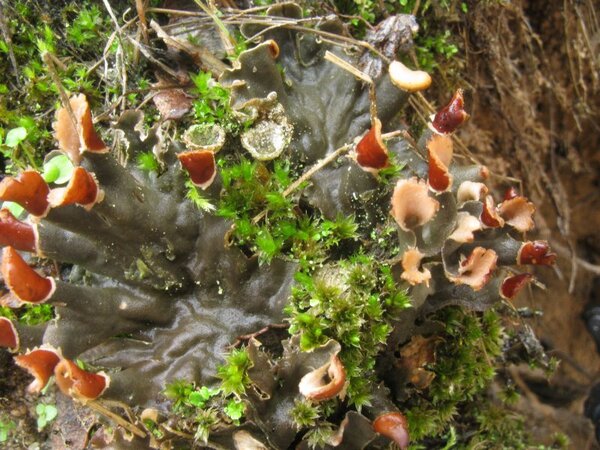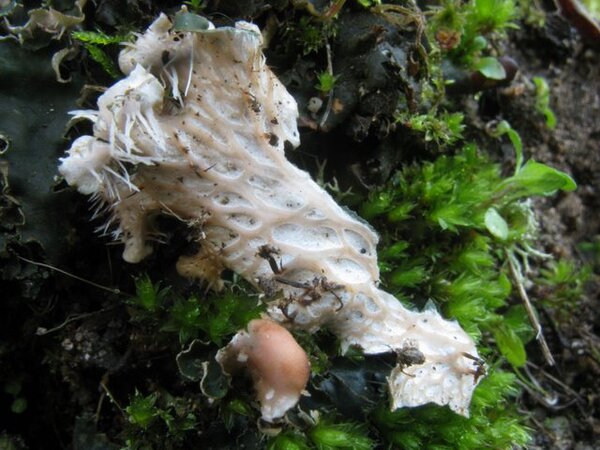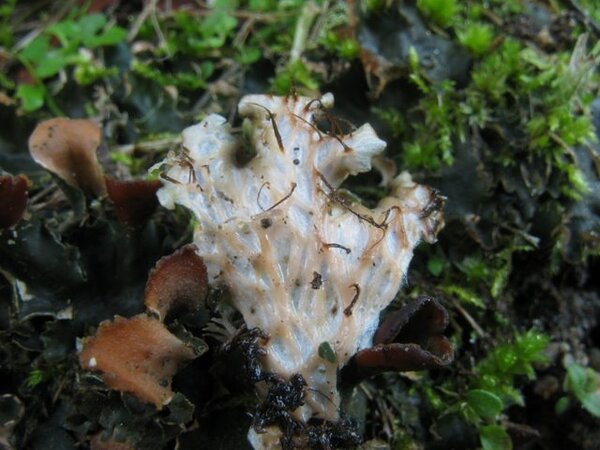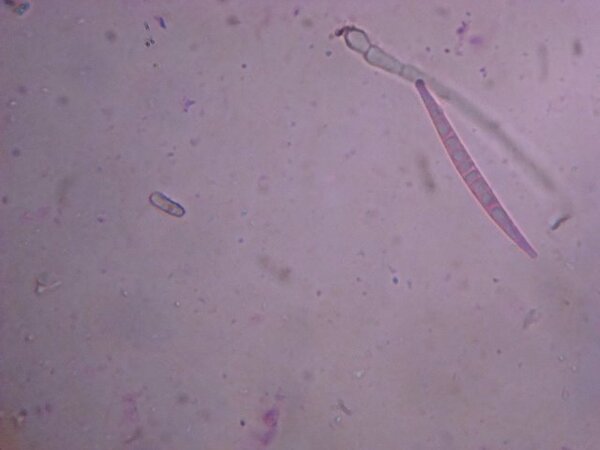Peltigera degenii Gyeln.
Magyar Bot. Lapok, 25: 253, 1927.
Synonyms: Peltigera canina f. nitens Anders; Peltigera degenii f. nitens (Anders) Oxner; Peltigera degenii var. nitens (Anders) Trass; Peltigera nitens (Anders) Gyeln.; Peltigera polydactylon var. submembranacea Nyl.; Peltigera praetextata var. nitens (Anders) Szatala; Peltigera virescens (J. Steiner) Gyeln.
Description: Thallus foliose, broad-lobed, heteromerous and dorsiventral, bluish grey when dry, blackish when wet, loosely attached, forming up to 12(-20) cm wide rosettes. Lobes elongate, flattened, contiguous, rounded at tips, 0.5-1(-1.5) cm broad, 2-5 cm long, with a bluish grey, glabrous, glossy, shiny, smooth to weakly wrinkled upper surface, the margins often up-turned, sometimes phyllidiate. Lower surface whitish near margins, pale brown in central parts, with whitish, raised veins becoming pale brown in central parts, and pale, mostly simple, up to 5-7 mm long rhizines. Upper cortex pseudoparenchymatous; medulla white; lower cortex absent. Apothecia frequent on up-turned short lobes, saddle-shaped, pale brown, 4-9 mm across. Paraphyses simple, distinctly thickened above. Asci 8-spored, fissitunicate, the thickened apex with a K/I+ blue ring, Peltigera-type. Ascospores 3-5-septate, hyaline turning pale brown at maturity, acicular, thin-walled, (40-)45-60(-68) x 2.5-5 μm. Photobiont cyanobacterial (Nostoc, the cells not in long chains). Spot tests: cortex and medulla K-, C-, KC-, P-, UV-. Chemistry: without lichen substances.
Growth form: Foliose, broad lobed
Substrata: soil, terricolous mosses, and plant debris
Photobiont: cyanobacteria, filamentous (e.g. Nostoc, Scytonema)
Reproductive strategy: mainly sexual
Commonnes-rarity: (info)
Alpine belt: absent
Subalpine belt: extremely rare
Montane belt: rather rare
Dry submediterranean belt: extremely rare
Humid submediterranean belt: extremely rare
Padanian area: absent
pH of the substrata:
1 2 3 4 5
Solar irradiation:
1 2 3 4 5
Aridity:
1 2 3 4 5
Eutrophication:
1 2 3 4 5
Poleotolerance:
0 1 2 3
Altitudinal distribution:
1 2 3 4 5 6
Rarity
absent
extremely rare
very rare
rare
rather rare
rather common
common
very common
extremely common
Loading data...
Occurrence data
Predictive map
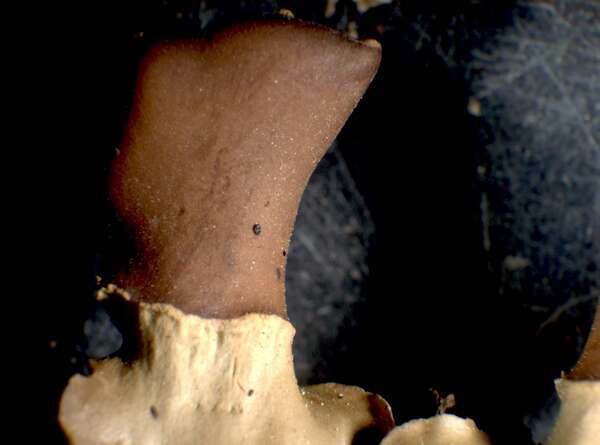
P.L. Nimis; Owner: Department of Life Sciences, University of Trieste
Herbarium: TSB (1849)
2001/12/05
apothecium
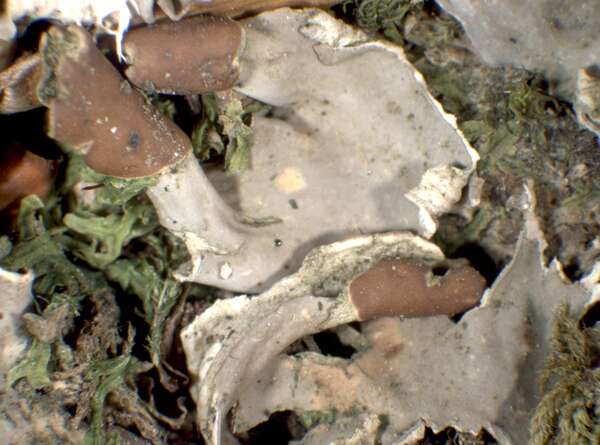
P.L. Nimis; Owner: Department of Life Sciences, University of Trieste
Herbarium: TSB (34836)
2002/02/16
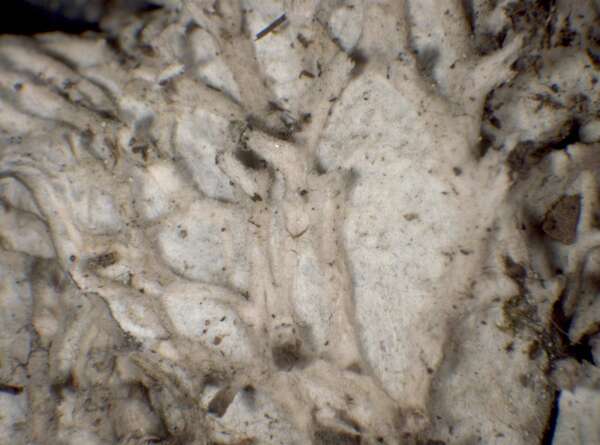
P.L. Nimis; Owner: Department of Life Sciences, University of Trieste
Herbarium: TSB (34836)
2002/02/16
raised veins on undersurface
Growth form: Foliose, broad lobed
Substrata: soil, terricolous mosses, and plant debris
Photobiont: cyanobacteria, filamentous (e.g. Nostoc, Scytonema)
Reproductive strategy: mainly sexual
Commonnes-rarity: (info)
Alpine belt: absent
Subalpine belt: extremely rare
Montane belt: rather rare
Dry submediterranean belt: extremely rare
Humid submediterranean belt: extremely rare
Padanian area: absent
pH of the substrata:
| 1 | 2 | 3 | 4 | 5 |
Solar irradiation:
| 1 | 2 | 3 | 4 | 5 |
Aridity:
| 1 | 2 | 3 | 4 | 5 |
Eutrophication:
| 1 | 2 | 3 | 4 | 5 |
Poleotolerance:
| 0 | 1 | 2 | 3 |
Altitudinal distribution:
| 1 | 2 | 3 | 4 | 5 | 6 |
Rarity
absent
extremely rare
very rare
rare
rather rare
rather common
common
very common
extremely common
Loading data...
Occurrence data
Predictive map

P.L. Nimis; Owner: Department of Life Sciences, University of Trieste
Herbarium: TSB (1849)
2001/12/05
apothecium

P.L. Nimis; Owner: Department of Life Sciences, University of Trieste
Herbarium: TSB (34836)
2002/02/16




